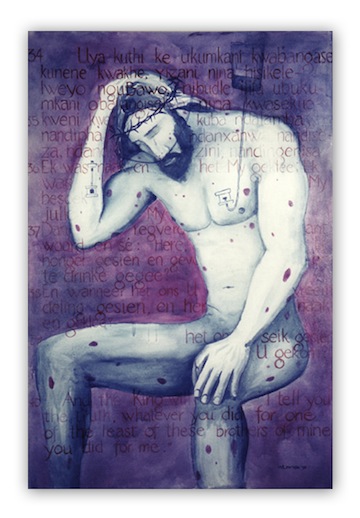The original title for this essay was ‘The Development and Justification of Violent and Extreme Depictions of Suffering in European Crucifixion Scenes of the Late Middle Ages’, but we’ll call it ‘The Evolution of the Crucifixion in Art’ for the sake of brevity.
In order to be more palatable as blog posts, this essay is broken up into seven shorter segments:
- Introduction
- Theological and ecclesiastical developments in the Western Church
- Social and cultural developments in the Western Church
- The conflated ‘Man of Sorrows’
- The intimate ‘Man of Sorrows’
- Grünewald’s masterpiece
- Conclusion
+++++
Introduction
The first time a Westerner sees the piece they might be unsure of what to make of it. The nude figure resembles familiar depictions of the Passion of Christ, bearing a crown of thorns, sitting with his head slumped over and eyes closed. But there are also two perplexing differences: this Christ is hooked up to an IV and covered with sores. One reads the title: Man of Sorrows: Christ with AIDS.1
 This is American artist Maxwell Lawton’s definitive work, but what is it doing? With such a striking representation of Christ perhaps Lawton is making a critique of some sort. Is it a profane image intended to mock American Christianity’s relative apathy toward the global AIDS crisis or more profane yet: to irreverently associate the judgmental American Evangelical view of Christ with the stigma-ridden communities associated with AIDS simply to upset conservative onlookers? Or was it Lawton’s goal to communicate something far more profound, relevant, personal and theologically significant?
This is American artist Maxwell Lawton’s definitive work, but what is it doing? With such a striking representation of Christ perhaps Lawton is making a critique of some sort. Is it a profane image intended to mock American Christianity’s relative apathy toward the global AIDS crisis or more profane yet: to irreverently associate the judgmental American Evangelical view of Christ with the stigma-ridden communities associated with AIDS simply to upset conservative onlookers? Or was it Lawton’s goal to communicate something far more profound, relevant, personal and theologically significant?
When we look into the long history of Christian art Lawton’s Christ with AIDS bears a striking resemblance to the images of Christ’s Passion that appeared in late medieval Europe from which he is intentionally borrowing. During this period we find images depicting extreme suffering in the context of a graphically violent—and in some respects, non-historical—crucifixion scene. It is our argument that these depictions of the ‘Man of Sorrows’ motif (in contrast to the common first-millennium depiction of ‘Christ in Victory’ motif) are justifiable in light of the developing theological, ecclesiastical and societal/cultural context of Europe in the Late Middle Ages. We will also analyse how these developments were demonstrated in late medieval religious art, paying special attention to Matthias Grünewald’s Isenheim Altarpiece.2
Read part two, Theological and ecclesiastical developments in the Western Church.
+++++
1 Maxwell Lawton, Man of Sorrows: Christ with AIDS, 1994, St George’s Cathedral, Cape Town. Maxwell Lawton, ‘Maxwell Lawton: Gallery’; Available from http://www.maxwelllawton.com/Flash/gallery.html; Internet; accessed 28 April 2011.
2 It must be acknowledged that even within the narrow context of the West—the Roman Catholic Church—these changes in devotional practice take place at different rates in different locations. Still, it is possible—with the evidence at our disposal—to come to definitive conclusions for Europe in general regarding its development. See Rachel Fulton, From Judgment to Passion: Devotion to Christ & the Virgin Mary, 800-1200 (New York: Columbia University Press, 2002), 63.

Discussion
Trackbacks/Pingbacks
Pingback: The Evolution of the Crucifixion in Art, part II – Theological & ecclesiastical developments in the Western Church « Things & Stuff - 29 April 2011
Pingback: The Evolution of the Crucifixion in Art, part III – Social & cultural developments in the Western Church « Things & Stuff - 29 April 2011
Pingback: The Evolution of the Crucifixion in Art, part IV – The conflated ‘Man of Sorrows’ « Things & Stuff - 30 April 2011
Pingback: The Evolution of the Crucifixion in Art, part V – The intimate ‘Man of Sorrows’ « Things & Stuff - 2 May 2011
Pingback: The Evolution of the Crucifixion in Art, part VI – Grünewald’s masterpiece « Things & Stuff - 4 May 2011
Pingback: The Evolution of the Crucifixion in Art, part VII – Conclusion « Things & Stuff - 5 May 2011